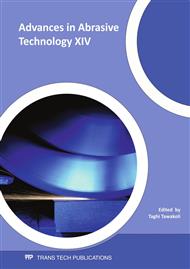[1]
S. Ogawa, S. Okumura, T. Hirogaki, E. Aoyama and Y. Onchi: Investigation of Eco-friendly Fixed-Abrasive Polishing with Compact Robot, Advanced Materials Research Vol. 126-128 (2010), p.415.
DOI: 10.4028/www.scientific.net/amr.126-128.415
Google Scholar
[2]
Z. Sun, S. Biller, F. Gu and L. Li: Energy Consumption Reduction for Sustainable Manufacturing Systems Considering Machines with Multiple-Power States, Proceedings of the ASME 2011 International Manufacturing Science and Engineering Conference, June 13-17, 2011, Corvallis, Oregon, USA.
DOI: 10.1115/msec2011-50069
Google Scholar
[3]
A.M.M. Sharif Ullah, K. Kitajima, T. Akamatsu, M. Furuno, J. Tamaki and A. Kubo: On Some Eco-indicators of Cutting Tools, Proceedings of the ASME 2011 International Manufacturing Science and Engineering Conference, June 13-17, 2011, Corvallis, Oregon, USA.
DOI: 10.1115/msec2011-50071
Google Scholar
[4]
—. CES SelectorÔ Version 5. 1. 0, 2009, Granta Design Limited, UK, http: /www. grantadesign. com.
Google Scholar
[5]
D. Dubois, L. Foulloy, G. Mauris and H. Prade: Probability-Possibility Transformations, Triangular Fuzzy Sets, and Probabilistic Inequalities, Reliable Computing, Vol. 10 (2004), p.273.
DOI: 10.1023/b:reom.0000032115.22510.b5
Google Scholar
[6]
G. Mauris, V. Lasserre and L. Foulloy: A fuzzy approach for the expression of uncertainty in measurement, Measurement, Vol. 29(3) (2001), p.165.
DOI: 10.1016/s0263-2241(00)00036-1
Google Scholar
[7]
R.Y. Tan, A. B. Culaba and R.I. Purvis: Application of possibility theory in the life-cycle inventory assessment of biofuels, International Journal of Energy Research, Vol. 26 (2002), pp.737-745.
DOI: 10.1002/er.812
Google Scholar
[8]
A.M.M. Sharif Ullah: A Fuzzy Decision Model for Conceptual Design, Systems Engineering, Vol. 8(4) (2005), p.296.
Google Scholar
[9]
A.M.M. Sharif Ullah: Handling Design Perceptions: An Axiomatic Design Perspective, Research in Engineering Design, Vol. 16(3) (2005), p.109.
DOI: 10.1007/s00163-005-0002-2
Google Scholar
[10]
A.M.M. Sharif Ullah, K.H. Harib and A. Al-Awar: Minimizing Information Content of a Design using Compliance Analysis, SAE Technical Paper 2007-01-1209, (2007).
DOI: 10.4271/2007-01-1209
Google Scholar
[11]
A.M.M. Sharif Ullah and K.H. Harib: An Intelligent Method for Selecting Optimal Materials and its Application, Advanced Engineering Informatics Vol. 22(4) (2008), p.473.
DOI: 10.1016/j.aei.2008.05.006
Google Scholar
[12]
A.M.M. Sharif Ullah: Logical interaction between domain knowledge and human cognition in design, International Journal of Manufacturing Technology and Management, Vol. 14(1-2) (2008), p.215.
DOI: 10.1504/ijmtm.2008.017496
Google Scholar


